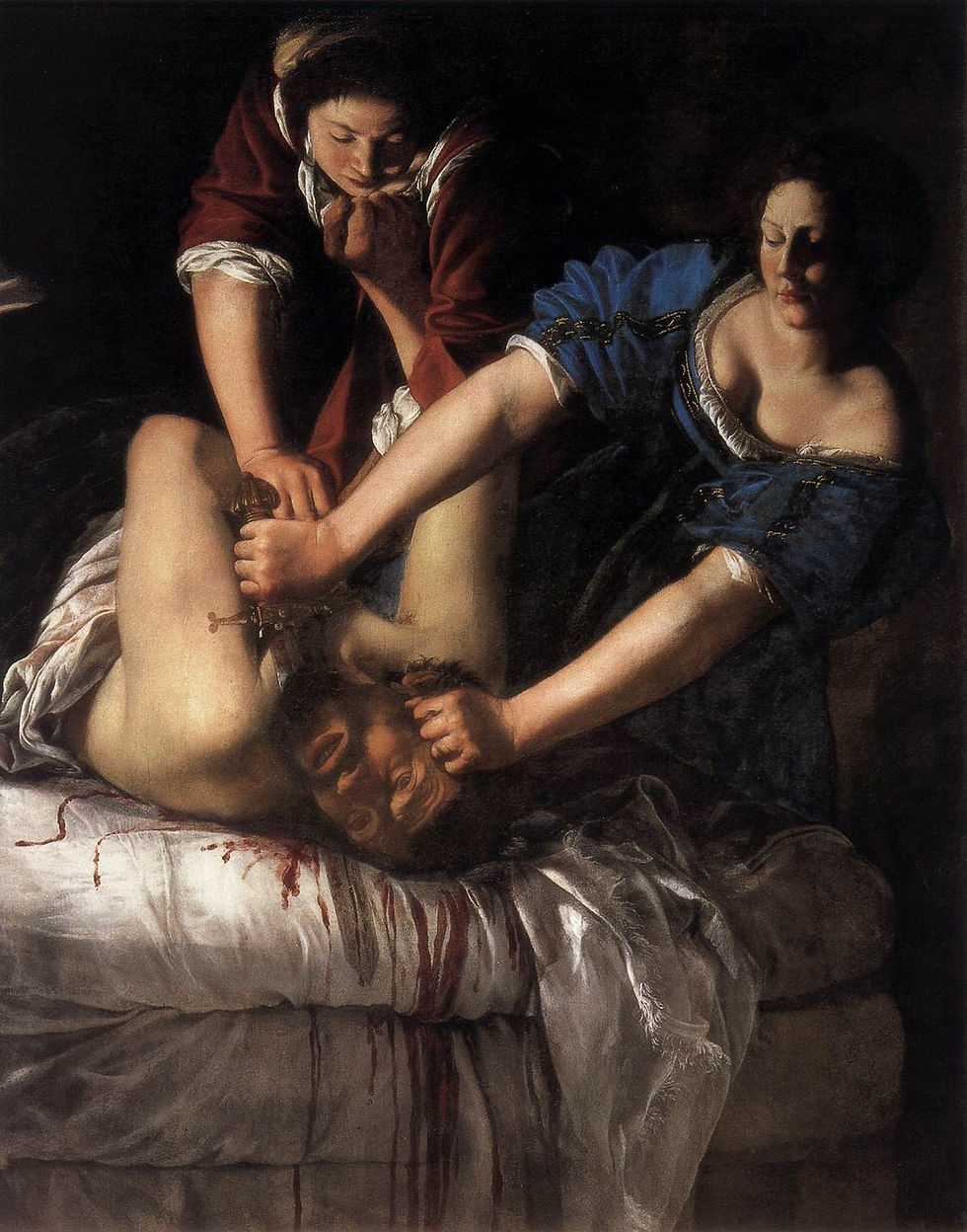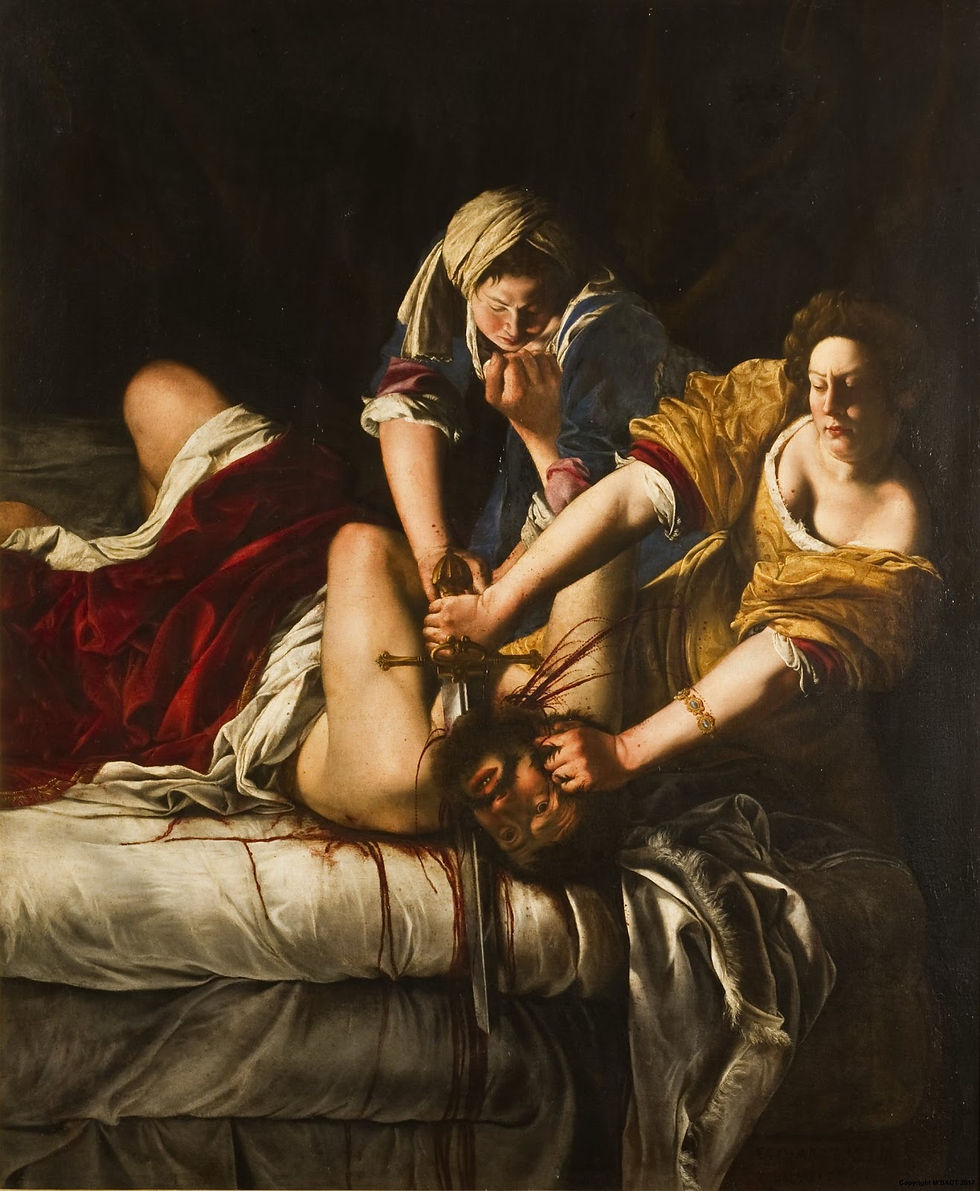Artemisia Exhibition Review
- Art Pot

- Apr 2, 2021
- 5 min read
Written by: Ilaria Bevan
Violence, sex, passion, trauma, drama - the National Gallery’s Artemisia exhibition has it all. Delayed in inevitable circumstances by six months, the exhibition did not disappoint and in fact, the long wait served to heighten the anticipation of the event.
The National Gallery, home to thousands of wonderful pictures created by a multitude of renowned artists from different periods, was a place I frequented during the last few months of lockdown ‘summer’. It was my place of refuge and it was such a joy to step back into this transcendent realm - I even saw the Titian exhibition twice. However, this visit was different. The excitement of the queue outside the National Gallery doors was a taste of the thrilling sensations that awaited visitors in the Sainsbury Wing.
Setting the scene of the exhibition, immediately past the introductory text in the first room, hung Susanna and the Elders, painted in 1610. Artemisia was only seventeen. Putting the shock (and slight jealousy) of discovering this fact aside, this picture certainly set high standards for the remaining seven rooms. The picture depicts the moment from the biblical story of Susanna from the Book of Daniel, where two older men voyeuristically gaze upon the bathing young maiden. The men then force her into sexual relations with false accusations of adultery. However, Artemisia rejects typical renditions of the story that portray Susanna as being unaware or even sometimes welcoming of her predator’s presence. Artemisia here depicts Susanna catching the men in their spying game as they are about to pounce. Susanna’s distressed facial expression paired with the dramatic pose that pushes away the men’s advances is extremely powerful. Rather than the moment being one of seduction, it is traumatic. One cannot help but recall Artemisia’s own suffering when she was raped by artist Agostino Tassi and compare it to that of Susanna. This connection is only strengthened by Artemisia modeling Susanna’s body from her own, which she achieved by studying herself in a mirror. In doing so Artemisia relives the trauma of her own sexual abuse, making the scene even more shocking.

Artemisia Gentileschi, Susanna and the Elders, 1610. Oil on canvas, 170cm x 119cm. Schloss Weißenstein, Ponnersfelden.
However, curator Letizia Treves doesn’t just allude to this torment through Artemisia’s paintings. Instead, she makes the viewer confront the brutal facts. The careful positioning of the worn manuscript that documents the trial of Artemisia and her father Orazio against studio assistant Agostino Tassi does just this. Such an explicit connection between Artemisia’s devastating art and harrowing life events both disquiet the viewer and, more importantly, creates a tragic, yet triumphant tone that resonates throughout the rest of the show. Nevertheless, although Tassi was found guilty of ‘deflowering’ Artemisia, he escaped punishment by fleeing Rome and because the Pope thought highly of his work. As it turns out, Tassi would suffer an altogether damning punishment, by being ignored by a modern audience.
It has always been recognized that Artemisia responded to Tassi’s assault in what are certainly her mightiest compositions. Hanging side-by-side set against a navy wall are both versions of Judith Beheading Holofernes, the first created between 1612-13 and the second between 1620-21. These exciting pictures depict the downfall of the great Assyrian general, Holofernes, as he is beheaded by Judith, accompanied by her maid Abra. Artemisia’s pictures are undoubtedly some of the most violent and exciting renditions of this biblical story. Blood spurts from Holofernes’ neck and drips down the crisp white bedsheets and Judith in mid-action stands determined to avenge the suffering of her people caused by the Assyrians. Artemisia’s decision to crop the scene and set it in a dimly lit bedroom adds intensity to the already sensational composition.

Artemisia Gentileschi, Judith Slaying Holofernes, c.1612-13. Oil on canvas, 158.8cm x 125.5c., Museo Capodimonte, Naples.
But one question remains, why did Artemisia paint a second, perhaps more sophisticated and thrilling, version? The first picture, made in Rome, introduces the dynamic elements of the composition including the fearless poses of Judith and Abra, the brilliant contrast of the scarlet blood against the white bed sheets, and the chiaroscuro in the dramatic and violent style of Caravaggio, who had treated this same theme c.1600. The second picture refines these rather theatrical components and appears to balance them with a certain elegance demonstrated in Judith’s expensive-looking costume complete with a jeweled arm bracelet and elaborately coiffured hair, as well as the deep red velvet drapery that covers the sleeping Holofernes. Before seeing this exhibition, I did not know a later picture existed and was delighted to see both pictures united side-by-side.

Artemisia Gentileschi, Judith Slaying Holofernes, c. 1620-21. Oil on canvas, 146.5cm x 108cm. Uffizi Gallery, Florence.
It is slightly disappointing to report that the rooms which followed such a promising start seemed to me decidedly less interesting. Although it was interesting to learn more about Artemisia’s marriage to modest Florentine artist Pierantonio Stiattesi, her affair with wealthy Florentine nobleman Franceso Maria Maringhi (displayed through rather defused translations of the correspondence between the lovers that hid the true raunchiness of their affectations) and her triumphs in Florence, Rome, Venice and Naples, nothing can compare to her earlier pictures. As I wandered through the dark coloured rooms, I could not help but feel as if her compositions had become repetitive, and dare I say it, a little dull. Amusingly, the texts that introduced each room that corresponded with a specific chapter in her life seemed to agree with me. Room six entitled “Illustrious Patrons” gave her backhanded compliments saying ‘even if her attempts were unsuccessful, Artemisia’s persistence and ambition remained unabated.’ Ouch.
Nevertheless, when I reached the final room there was one last trick up the National Gallery’s sleeve. Concluding the exhibition is Artemisia's final self-portrait: Self-Portrait as the Allegory of Painting, also known as La Pittura (1638-39). In this fine composition, Artemisia is depicted as painting herself. In doing so, she presents herself as a fine artist, one that rivals leading male contemporaries such as Caravaggio. Although one might suggest that this composition is not as accomplished as her earlier self-portraits including Self-Portrait as a Lute Player (c.1616-18) and the recently restored Self-Portrait as Saint Catherine of Alexandria (c.1615-17), it is perhaps her most striking. Unlike these previous pictures, where Artemisia envisions herself in different guises, La Pittura presents Artemisia as she was - an empowered female artist. Although some critics believe that this image is rather egotistical, I have to disagree. Painted in loose brushwork in a simple, earthy colour palette, Artemisia does not try to glamorise her image to better herself, and womankind, in a patriarchal world. Instead, this picture makes you look back at her entire body of work, or in this case the previous rooms in the exhibition, and ultimately remind you of her undeniable talent.

Artemisia Gentileschi, Self-Portrait as the Allegory of Painting (La Pittura), c.1938-39. Oil on canvas, 96.5cm x 73.7cm, Royal Collection, London.




Kommentare